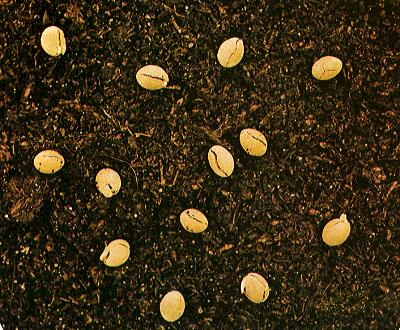
Vegetable seeds are often coated
or pelleted before planting. Coated seeds have a thin layer of material
such as clay, diatomaceous earth, rhizobium, or chemicals, such as a fungicide
treatment, added to the seed surface. These materials may make the seeds
larger but do not change their overall shape. Seeds are coated to make them
easier to handle, to deliver chemical treatments, to improve contact between
the soil and seed, or to inoculate the seeds with microbes. Film coating
is a popular treatment adapted from the pharmaceutical industry. Film coated
seeds look similar to M & M candies because they give the seed a distinct
colored coating that is dust-free and improves the flowability of the seeds.
Pelleted seeds are coated until they have a round shape like the ones pictured
here. The larger round shape makes the seeds easier to handle and plant,
particularly when belt seeders are used with a specific hole size. Pelleted
seeds are often color coded to simplify identification since seeds cannot
be seen inside the pellet. The pelleting treatment shown here splits upon
hydration and does not pose a barrier to radicle growth or limit oxygen
uptake by the embryo.
next slide

